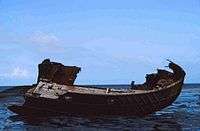Saltwick Bay
Saltwick Bay is a north-east facing bay approximately one mile (1.6 km) to the east of Whitby, on the east coast of North Yorkshire, England.[1] The bay contains the Saltwick Nab alum quarries, listed under the Ancient Monuments and Archaeological Areas Act 1979.[2] The bay is part of the Saltwick Formation and known for its collections of fossils. The SS Rohilla hospital ship sank in the bay in 1914, and the fishing trawler Admiral Van Tromp was shipwrecked there in 1976. The bay is accessible through Whitby Holiday Park.[3]
| Saltwick Bay | |
|---|---|
 Saltwick Bay | |
| Shire county | |
| Region | |
| Country | England |
| Sovereign state | United Kingdom |
| Police | Cleveland |
| Fire | Cleveland |
| Ambulance | North East |
History

Alum was quarried at Saltwick Bay, with the first recorded quarrying being by Sir Hugh Chomley, who lived at Whitby Abbey, in the 17th century.[4][5][6] The alum quarries were built on promontories and were 590 feet (180 m) in length and 115 feet (35 m) in depth. The quarries eventually closed in 1791.[2] There is also evidence of a medieval harbour at Saltwick Bay, and in the 18th century, Saltwick Bay and Whitby Harbour had a one-mile (1.6 km) triangular shale reef.[4]
Quarrying led to the discovery of fossils, and the bay is now known as being a location for fossils from the Lower Jurassic period.[5][7][8][9] Fossils commonly found at Saltwick Bay include the Dactylioceras and Hildoceras, as well as fossilised plant remains. Cuspiteuthis tubularis fossils can be found near the Black Nab, an island in the bay.[7][10] In around 1764, a horse skeleton was found about 30 yards (27 m) underground in the alum mines at Saltwick Bay,[11]:400 and in 1824, an almost complete skeleton of the extinct teleosaurid Steneosaurus bollensis was discovered at the bay. The skeleton is now displayed at the Whitby Museum.[8][11]:405–406 Skeleta of Steneosaurus brevior, another crocodile, have been found at the bay.[11]:408 Other skeleta found at Saltwick Bay have included the ichthyosaur and the plesiosaur.[11]:411–413
In 1914, the hospital ship SS Rohilla sank near Saltwick Nab in the bay; 146 of the 229 on board, including Captain Neilson and all the nurses, as well as Titanic survivor Mary Kezia Roberts, survived.[12] The conditions made rescue extremely difficult, but lifeboats from Whitby, Upgang (near Whitby), Redcar, Tynemouth and Scarborough attempted to close on the wreck.[12][13][14][15] In 1917, the SS Brentwood, which was owned by William Cory and Son Ltd, was sunk in Saltwick Bay by German mines.[16] During the Second World War, the bay was used as a gun point.[17] In 1976, the trawler Admiral von Tromp was wrecked in the bay, and two people on board died; the remains of the trawler are still visible in the bay.[18]
References
- "Whitby Abbey and the coast". Where2Walk. Retrieved 10 September 2016.
- Historic England. "Saltwick Nab alum quarries (1017779)". National Heritage List for England. Retrieved 10 September 2016.
- "Whitby Beaches". Whitby Online. Retrieved 10 September 2016.
- Barker, Rosalin (2011). The Rise of an Early Modern Shipping Industry: Whitby's Golden Fleet, 1600-1750. Boydell Press. p. 56. Retrieved 10 September 2016.
- "History of the Alum Mines at Saltwick Bay". Coast Dale Parks. 6 February 2016. Retrieved 10 September 2016.
- Baines, Stephen (August 2015). Captain Cook's Merchant Ships: Freelove, Three Brothers, Mary, Friendship, Endeavour, Adventure, Resolution and Discovery. The History Press. Retrieved 10 September 2016.
- "Saltwick Bay". UK Fossils. Retrieved 10 September 2016.
- "Whitby's Fossil History and Museum". Deposits Magazine. Retrieved 10 September 2016.
- Buhaenko, Helen (28 March 2009). "Coast watch: Tracing the footsteps of dinosaurs and Dracula in Whitby". The Independent. Retrieved 10 September 2016.
- Maddra, Richard (3 January 2014). "Bitten ammonites from the upper Lias Group (Lower Jurassic) of Saltwick Bay, Whitby, North Yorkshire, UK". Yorkshire Geological Society. Retrieved 10 September 2016.
- Benton, M.J.; Taylor, M.A (February 1984). "Marine Reptiles from the Upper Lias (Lower Toarcian, Lower Jurassic) of the Yorkshire Coast" (PDF) (pdf). University of Bristol. Retrieved 10 September 2016.
- Hocking, Charles (1969). Dictionary of Disasters at Sea During the Age of Steam: Vol II. London: Lloyd's Register of Shipping. p. 594.
- "Titanic Survivors". Encyclopedia Titanica. Retrieved 29 July 2014.
- "The Wrecked Hospital Ship". The Times. London. 1 November 1914. p. 1.
- "Hospital Ship Wreck". The Times. London. 2 November 1914. p. 3.
- Allen, Tony; Racey, Carl (15 September 2010). "SS Brentwood [+1917]". WreckSite. wrecksite.eu. Retrieved 10 September 2016.
- Green, Barbara (November 2011). Girls in Khaki: A History of the ATS in the Second World War. The History Press. Retrieved 10 September 2016.
- "The mysterious sinking of the Admiral Von Tromp". Scarborough Maritime Heritage Centre. Retrieved 10 September 2016.